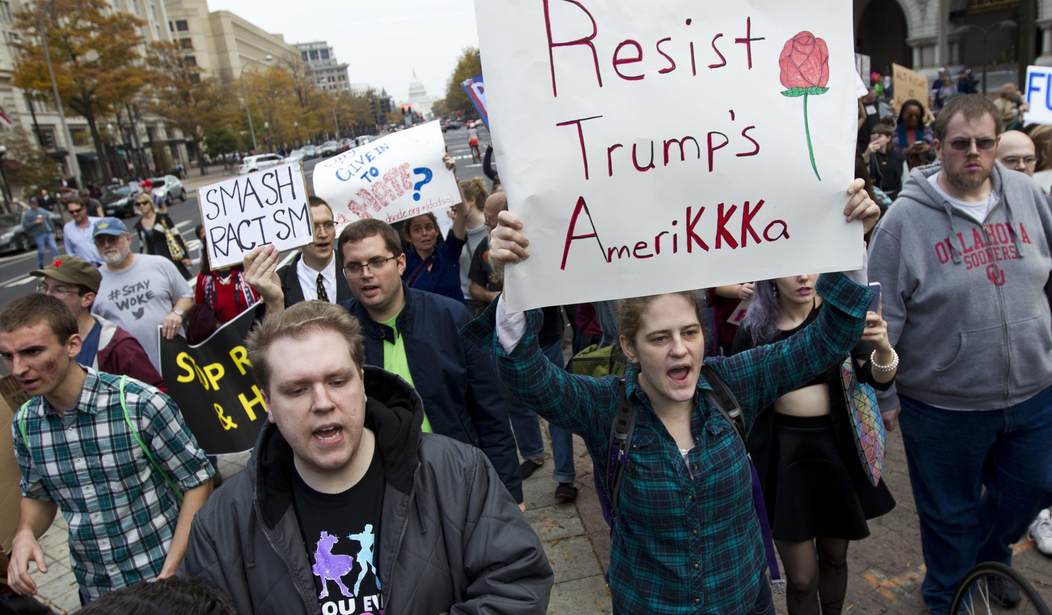If you subscribe, as I do, to the digital edition of the New York Times, you’ll soon notice that just about every headline or subhed will contain some reference to President Trump. It almost doesn’t matter what the ostensible subject of the article is; the hed must include some aside about “the age of Trump,” even if the story is about golf or gardening. Because, you see, everything is political today. Naturally, this is especially true in the overtly political stories as well. For example, here’s the run-up to something that happens every two years, a nationwide congressional election:
A Nation in Turmoil Prepares to Deliver a Verdict on Trump
Not the American Republic going to the polls to elect the entire House of Representatives, along with one-third of the Senate. No, “a nation in turmoil” preparing to “deliver a verdict” on Donald J. Trump, who’s not even on the ballot.
Let’s boldface the buzzwords!
The tumultuous 2018 midterm campaign, shaped by conflicts over race and identity and punctuated by tragedy, barreled through its final weekend as voters prepared to deliver a verdict on the first half of President Trump’s term, with Republicans bracing for losses in the House and state capitals but hopeful they would prevail in Senate races in areas where Mr. Trump is popular.
The president was set to storm across two states Saturday, two Sunday and three Monday in an effort to pick off Senate seats in Indiana, Florida and a handful of other battlegrounds where Republicans hope to add to their one-seat majority in the chamber. Democrats and liberal activists, galvanized by opposition to Mr. Trump, gathered Saturday to knock on doors and make turnout calls from Pennsylvania to Illinois to Washington to try to erase the G.O.P.’s 23-seat House majority.
The run-up to the election, widely seen as a referendum on Mr. Trump’s divisive persona and hard-line policy agenda, has revealed deep strains in the president’s political coalition and left him confined to campaign in a narrow band of conservative communities. Republicans’ intermittent focus on favorable economic news, such as the Friday report showing strong job growth, has been overwhelmed by Mr. Trump’s message of racially incendiary nationalism.
And that’s just the first three paragraphs. Here’s the fourth:
While Mr. Trump retains a strong grip on many red states and working-class white voters, his jeremiads against immigrants and penchant for ridicule have proved destabilizing, with the party losing more affluent whites and moderates in metropolitan areas key to control of the House.
Here’s the sixth:
In several diverse Sun Belt states where Republicans had shown resilience, such as Texas, Florida and Arizona, their candidates have seen their numbers dip in polling as Mr. Trump has given up the unifying role that American presidents have traditionally tried to play.
The media dropped the fig leaf of “objectivity” decades ago but it wasn’t until the presidential election of 2016 that the major newspapers and television networks stood revealed in such bare-assed naked splendor. Now, Democrat outlets like the Times don’t just tell you what happened, they tell you what is going to happen and how you should feel about it.
You know, just like in 2016.
UPDATE: Meanwhile, the AP chimes in with this smear:
President Donald Trump is in the final stretch of a 44-city blitz for the midterm elections, but the America he’s glimpsed from the airport arrivals and his armored limousine is hardly a reflection of the nation as a whole.
The president has mostly traveled to counties that are whiter, less educated and have lower incomes than the rest of the United States, according to Census Bureau data. It’s a sign that he is seeking to galvanize the same group of voters that helped carry him to victory in 2016.
Which thematically ties right into this story in the Times:
White supremacists and other far-right extremists have killed far more people since Sept. 11, 2001, than any other category of domestic extremist. The Anti-Defamation League’s Center on Extremism has reported that 71 percent of the extremist-related fatalities in the United States between 2008 and 2017 were committed by members of the far right or white-supremacist movements. Islamic extremists were responsible for just 26 percent. Data compiled by the University of Maryland’s Global Terrorism Database shows that the number of terror-related incidents has more than tripled in the United States since 2013, and the number of those killed has quadrupled. In 2017, there were 65 incidents totaling 95 deaths. In a recent analysis of the data by the news site Quartz, roughly 60 percent of those incidents were driven by racist, anti-Muslim, anti-Semitic, antigovernment or other right-wing ideologies. Left-wing ideologies, like radical environmentalism, were responsible for 11 attacks. Muslim extremists committed just seven attacks.
These statistics belie the strident rhetoric around “foreign-born” terrorists that the Trump administration has used to drive its anti-immigration agenda. They also raise questions about the United States’ counterterrorism strategy, which for nearly two decades has been focused almost exclusively on American and foreign-born jihadists, overshadowing right-wing extremism as a legitimate national-security threat. According to a recent report by the nonpartisan Stimson Center, between 2002 and 2017, the United States spent $2.8 trillion — 16 percent of the overall federal budget — on counterterrorism. Terrorist attacks by Muslim extremists killed 100 people in the United States during that time. Between 2008 and 2017, domestic extremists killed 387 in the United States, according to the 2018 Anti-Defamation League report.
“We’re actually seeing all the same phenomena of what was happening with groups like ISIS, same tactics, but no one talks about it because it’s far-right extremism,” says the national-security strategist P. W. Singer, a senior fellow at the New America think tank.
Never mind that Richard Spencer and other fringe figures on the “alt-right” are not at all conservative in any meaningful sense of the word. Have a look:
But no matter, the media will continue to insist that he is, and that the National Socialist German Workers’ Party in Germany had nothing to do with “real” Socialism.
In short, we’re witnessing classic media cultural Marxism in action, something both deceitful and deeply un-American. But this is how the media seeks to divide us.









Join the conversation as a VIP Member